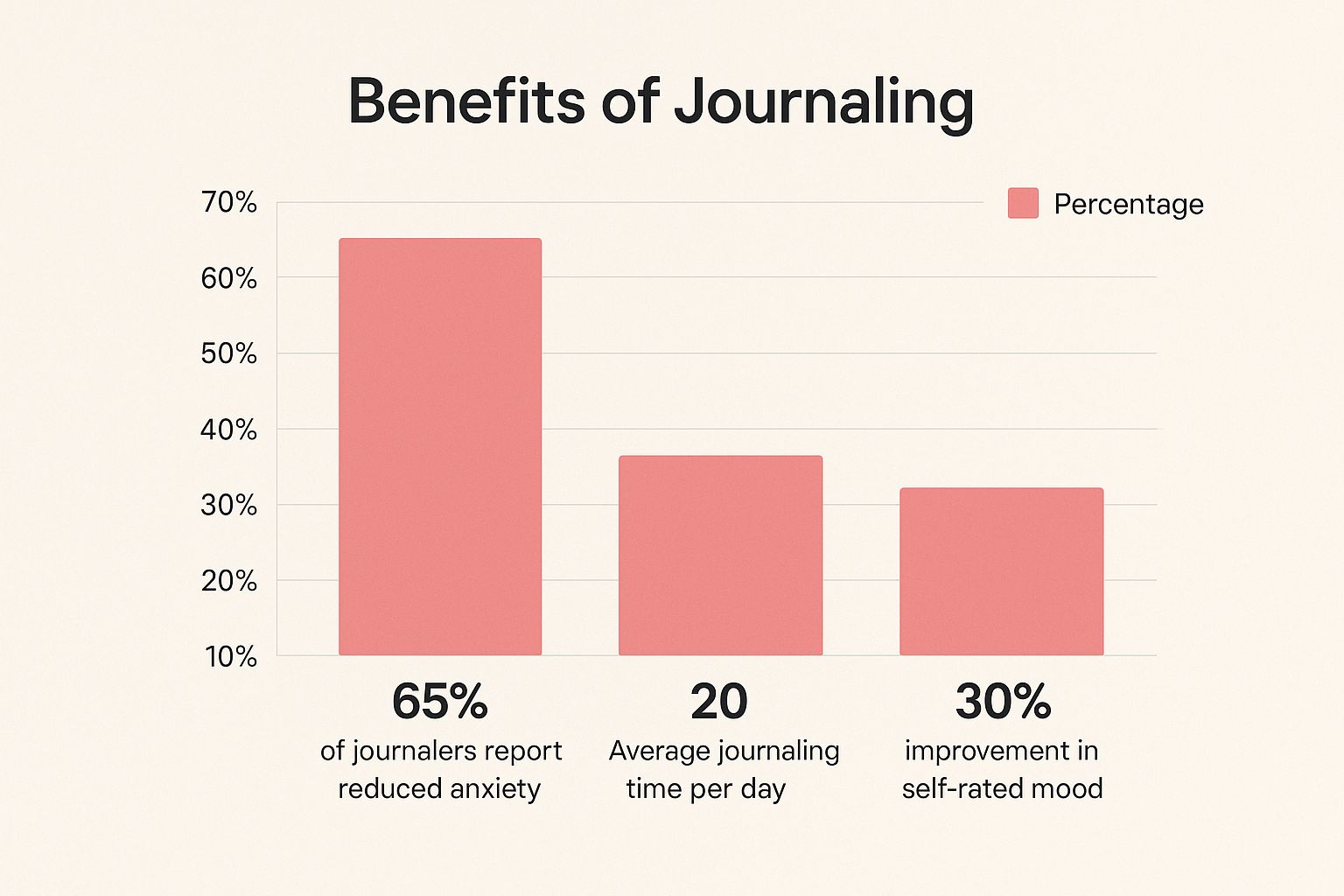Journaling for Mental Health: Benefits & How to Start
The Real Science Behind Why Journaling Works
Journaling for mental health is more than just a passing trend; it's a powerful tool supported by scientific research. It helps us unravel tangled thoughts and emotions, giving them structure outside the confines of our minds. But how does the simple act of writing create tangible mental health benefits?
Neurological Benefits of Journaling
Journaling engages key brain areas linked to emotional processing, self-awareness, and stress reduction. When you write, you activate the prefrontal cortex, responsible for planning, decision-making, and working memory. This helps organize thoughts and make sense of experiences. Journaling also calms the amygdala, the brain's emotional center, which can become overactive during stressful periods. This calming effect helps regulate emotional responses and promotes a sense of peace. Journaling creates a mental map of your inner world, bringing order to chaos and allowing for clearer emotional navigation.
Research on Journaling for Mental Health
The positive effects of journaling have been shown in numerous studies. A 2022 meta-analysis, the first of its kind to focus on journaling as a clinical intervention, analyzed studies from various countries and populations. The research found that journaling led to a statistically significant 5% average reduction in mental health symptoms compared to control groups. Anxiety symptoms decreased by 9%, PTSD symptoms by 6%, and depression symptoms by 2%. Learn more about the impact of journaling for mental health here. These findings highlight journaling's potential for managing a range of mental health challenges.
To further illustrate the benefits of journaling, let's examine the data in the table below. It provides a comparison of symptom reduction percentages based on several studies focusing on different mental health conditions.
Research-Backed Benefits of Journaling by Mental Health Condition
| Mental Health Condition | Symptom Reduction % | Study Duration | Recommended Frequency |
|---|---|---|---|
| Anxiety | 9% | 8 weeks | Daily |
| PTSD | 6% | 12 weeks | 3 times per week |
| Depression | 2% | 6 weeks | Every other day |
As this table demonstrates, the benefits of journaling can vary depending on the mental health condition and the duration and frequency of the practice. While all conditions saw improvement, anxiety showed the greatest reduction in symptoms with regular, daily practice.

The infographic above further highlights the positive impact: 65% of journalers reported reduced anxiety, with 20 minutes of daily journaling leading to a 30% improvement in self-rated mood. These statistics reinforce the link between consistent journaling and better mental well-being. Even short periods of journaling can lead to significant positive changes.
Putting the Science into Practice
Understanding the science behind journaling allows you to use it effectively. By consciously engaging with the process, you maximize its benefits. For example, focusing on describing your emotions, rather than just recounting events, deepens self-awareness. This involves labeling emotions with specific words and exploring contributing factors. This type of expressive writing facilitates more effective processing of difficult emotions and the development of healthier coping mechanisms. These insights underscore journaling's power to create positive change.
Building a Journaling Habit That Actually Sticks

Forget aiming for the perfect daily journal entry. Instead, focus on creating a journaling practice that genuinely fits your life. This means understanding yourself, preparing for life's changes, and avoiding common pitfalls.
Choosing the Right Time and Environment
The right time is crucial for a lasting journaling routine. Are you a morning person or a night owl? If mornings work, set aside 15 minutes before the day begins. If evenings are better for unwinding, reserve time before bed.
Also, create a comfortable, inviting space without distractions. This dedicated space signals to your brain that it's time for self-reflection.
Adapting to Life's Changes
Life is full of changes, so your journaling should adapt. During busy times, shorter entries are just as valuable. A quick gratitude list or a reflection on one positive experience can still benefit your mental health.
This flexibility helps maintain the habit even when time is short. Remember, consistency matters more than volume. Even five minutes can make a difference.
Overcoming Perfectionism
One of the biggest obstacles is the pressure to write perfectly. Let go of that. Your journal is a private space for your thoughts and feelings.
Don't worry about grammar or eloquent writing. Just write. Think of it as talking to a close friend—honest and unedited. This authenticity makes journaling so powerful.
Sticking to a routine is a big factor in positive mental health. Journaling at least weekly is sustainable for many. A study found that 66.4% maintained weekly journaling, though rates ranged from 41.7% to 100% depending on the group. Explore this topic further. Find what works for you and keep at it.
Proven Techniques That Transform Your Mental Health
Journaling for mental health offers more than just a daily record; it provides specific techniques to boost emotional well-being. Just as different tools serve different purposes, various journaling methods offer unique benefits. This section explores effective techniques for stress management and emotional regulation.
Gratitude Journaling: Focusing on the Positive
Gratitude journaling involves regularly noting things you appreciate. This simple act shifts focus from what's missing to what's present in your life. Instead of fixating on a frustrating experience, you might write about a small joy, like a sunny day or a kind gesture. This practice cultivates appreciation and boosts positivity.
Expressive Writing: Processing Difficult Emotions
Expressive writing explores challenging experiences and emotions. It involves delving into your thoughts and feelings about a specific event or situation. This method helps process trauma, grief, or other difficult emotions. The goal isn't to dwell on negativity but to understand and accept those feelings.
CBT-Inspired Journaling: Challenging Negative Thoughts
Cognitive Behavioral Therapy (CBT)-inspired journaling challenges negative thought patterns. This technique identifies negative thoughts, analyzes their validity, and reframes them positively or realistically. For example, if anxious about a presentation, CBT-inspired journaling would encourage you to examine the anxiety's source and develop constructive thoughts.
Balancing Positive and Negative Entries: Finding Equilibrium
While exploring challenging emotions is valuable, balancing it with positive reflection is essential. A mixed-methods study emphasized this balance. Among consistent journalers (three times a week for 12 weeks), 73% reported reduced stress, and 65% experienced improved mood. Those who journaled about both positive and negative experiences saw the most significant, balanced benefits. Find more detailed statistics here. This suggests combining gratitude and expressive writing leads to more comprehensive mental health improvements.
To better understand the various journaling techniques and their applications, take a look at the table below:
To help illustrate the different techniques and their benefits, we've compiled the following table:
Journaling Techniques and Their Primary Mental Health Benefits: Overview of different journaling methods and their specific applications for various mental health goals.
| Journaling Technique | Primary Benefit | Best For | Time Required | Difficulty Level |
|---|---|---|---|---|
| Gratitude Journaling | Increased positivity, appreciation | Cultivating a positive mindset | 5-10 minutes | Beginner |
| Expressive Writing | Emotional processing, stress reduction | Coping with difficult emotions | 15-20 minutes | Intermediate |
| CBT-Inspired Journaling | Challenging negative thoughts, improving self-awareness | Managing anxiety and depression | 20-30 minutes | Intermediate/Advanced |
This table summarizes the key differences and similarities between various journaling methods, allowing you to choose the technique best suited to your individual needs and goals. Remember, the best approach is often the one that resonates most with you.
Practical Tips for Applying These Techniques
-
Start Small: Begin with a few minutes daily, gradually increasing the duration as you become more comfortable.
-
Be Consistent: Regular journaling is crucial for experiencing benefits. Short, frequent entries are more effective than occasional long ones.
-
Experiment with Different Techniques: Try gratitude journaling one week, then expressive writing the next, to discover what resonates. You might be interested in: 8 Journal Prompts for Anxiety Relief.
-
Don't Judge Yourself: Your journal is a private space. Don't worry about grammar or perfect prose.
By incorporating these proven techniques, you transform journaling from a simple diary into a powerful tool for cultivating emotional resilience and lasting mental well-being.
Digital Vs Paper: Finding Your Perfect Match
The format you choose for journaling can significantly influence your mental well-being journey. Both digital and traditional pen-and-paper methods offer unique benefits, catering to individual preferences and needs. Let's explore the pros and cons of each to help you make the best decision for your journaling practice.
The Tactile Allure of Pen and Paper
For many, the physical act of writing is therapeutic in itself. The feel of pen on paper, the soft scratching sound, and seeing your thoughts flow onto the page creates a tangible connection with your inner self. This tactile experience can be incredibly grounding and mindful. Studies even suggest that handwriting can improve memory retention and comprehension, deepening your understanding of your thoughts and feelings. The privacy offered by a physical journal is also a significant advantage for some. There's no need to worry about passwords, data breaches, or accidental sharing, which can be especially important when exploring sensitive topics.
The Tech-Savvy Approach: Digital Journaling
Digital journaling offers undeniable convenience. Journaling apps like Day One and Penzu are readily available, offering features like password protection, cloud storage, and searchable entries. Many apps also offer intelligent prompts and mood trackers, allowing you to explore your emotions more deeply and identify patterns over time. Digital platforms also offer accessibility features, such as text-to-speech and adjustable font sizes, making them inclusive for diverse needs. Plus, digital journals are easy to keep with you at all times, eliminating the need to carry a physical notebook. This lets you capture thoughts and reflections whenever inspiration strikes. However, it's crucial to be mindful of privacy concerns and choose reputable apps with robust security measures.
Comparing Digital and Paper Journaling
The table below summarizes the key differences between digital and paper journaling to help you weigh your options:
| Feature | Digital Journaling | Paper Journaling |
|---|---|---|
| Accessibility | High; adaptable features, readily available | Moderate; requires physical notebook and pen |
| Convenience | High; always accessible, searchable entries | Moderate; requires carrying a physical notebook |
| Privacy | Moderate; potential for data breaches, requires strong passwords | High; physical control, no risk of data breaches |
| Cost | Varies; free apps available, some require subscriptions | Low; cost of notebook and pen |
| Tactile Experience | Low; lacks the physical feel of writing | High; provides a sensory and mindful writing experience |
This comparison clearly highlights the distinct advantages and disadvantages of each method. The best choice truly depends on your individual preferences and what you prioritize in a journaling experience.
Integrating Creativity: Exploring Art Therapy
Consider incorporating art therapy into your journaling practice. For example, explore the world of therapeutic coloring pages, a mindful activity that reduces stress and promotes creative expression. This can be combined with both digital and paper methods.

Whether you prefer the structured layout of a digital journal or the freedom of a blank page, choosing the right format is essential for establishing a sustainable journaling habit for mental well-being. Consider your lifestyle, preferences, and mental health goals to find your perfect match. Ultimately, the most important factor is finding a method you enjoy and can maintain in the long run.
Overcoming Mental Blocks and Common Obstacles
Maintaining a consistent journaling practice for mental health can be challenging, even with the best intentions. Life's demands, waning motivation, and the occasional struggle to find the right words can all create obstacles. This section addresses these common hurdles and provides practical solutions to keep your mental health journaling on track.
Tackling Perfectionism and Writer's Block
Many people abandon journaling due to the pressure of writing perfectly. Remember, your journal is a personal space for thoughts and feelings, not a polished manuscript. Don't worry about grammar or eloquent phrasing; just write.
If writer's block strikes, try using prompts. Simple questions like "What am I grateful for today?" or "What did I learn today?" can help jumpstart your writing.
Managing Time Constraints and Shifting Priorities
Time is often a significant barrier to regular journaling. However, even short bursts of journaling can be beneficial. Five minutes of focused reflection is better than none.
If your schedule is packed, try incorporating journaling into existing routines. Journal during your commute (if you're not driving!), while waiting for an appointment, or during your lunch break. Adaptability is key.
Confronting Difficult Emotions and Trauma
Journaling can be a powerful tool for processing difficult emotions, but confronting painful experiences can be daunting. Start slowly, writing about less intense emotions and gradually working towards more challenging topics.
If you're dealing with trauma, consider seeking guidance from a mental health professional before exploring these experiences through writing. You might also find this helpful: Learn more in our article about dealing with depression.
Maintaining Motivation and Dealing With Setbacks
Motivation naturally ebbs and flows. There will be days when you don't feel like writing. That's perfectly normal. Don’t be hard on yourself. Acknowledge the resistance and try to understand its root cause.
Perhaps you're feeling overwhelmed, tired, or simply not in the mood. Gently remind yourself of the benefits of journaling and try writing just a few sentences. Even a small effort can rekindle your motivation. If you experience a longer break, don't get discouraged. Simply start again when you're ready. There's no need to catch up or pressure yourself to write excessively; just pick up where you left off, or start fresh.
Adapting Journaling to Life Transitions
Major life transitions, such as moving, changing jobs, or experiencing loss, can significantly impact mental health. During these periods, your journaling practice may need to adapt. You might find yourself journaling more often or focusing on specific challenges related to the transition. Be flexible and allow your journaling practice to evolve with your needs.
Consistency is key to realizing the benefits of journaling for mental health. By understanding and addressing these common obstacles, you can develop a sustainable journaling practice that supports your well-being through life's ups and downs.
Advanced Strategies for Maximum Mental Health Impact

Once you’ve established a regular journaling practice for your mental health, you can explore advanced techniques to maximize its benefits. This means moving beyond simply recording daily events and diving into deeper self-reflection and analysis.
Structured Reflection Frameworks: Adding Depth to Your Insights
Using structured reflection frameworks can provide valuable support for your journaling. For example, consider the STAR method (Situation, Task, Action, Result) to analyze challenging situations and identify areas for growth.
This framework encourages a more objective and analytical approach to understanding your experiences. Another useful technique is a SWOT analysis (Strengths, Weaknesses, Opportunities, Threats).
A SWOT analysis can be applied to personal development and goal setting within your journal. Applying these frameworks helps you gain a more complete understanding of your responses to different situations and identify recurring patterns.
Emotion Pattern Tracking: Unveiling Your Emotional Landscape
Tracking your emotions over time can reveal valuable insights into your mental health triggers and coping mechanisms. Create a simple table in your journal to log your emotions daily or weekly, noting the intensity and any associated events.
This practice helps you recognize recurring emotional patterns and identify potential stressors. You might notice, for example, that feelings of anxiety increase during periods of high workload. Or, perhaps certain social interactions consistently trigger feelings of sadness.
This awareness allows you to develop more effective coping strategies and make proactive changes to improve your mental well-being. You might be interested in: Learn more in our article about how to build mental toughness.
Integrating Journaling With Other Wellness Practices
Journaling can be a powerful addition to other wellness practices. Combine journaling for mental health with mindfulness meditation by reflecting on your experiences during meditation sessions. This can enhance self-awareness and deepen your understanding of your inner world.
You can also incorporate journaling into your exercise routine. Reflect on your physical and mental state before, during, and after workouts. This can reveal connections between your physical and emotional well-being.
Staying consistent with a journaling practice can be challenging. Writer's block isn’t the only thing that can halt your journaling. For ideas on how to handle this, read: Overcoming Writer's Block.
Safely Processing Complex Emotions and Trauma
While journaling can be beneficial for processing difficult emotions, navigating trauma requires careful consideration. If you are struggling with traumatic experiences, consider seeking guidance from a mental health professional before exploring these events in your journal.
A mental health professional can provide support and ensure you have healthy coping mechanisms in place. Your journal should be a safe space for exploration and healing, not a source of further distress.
This means approaching sensitive topics with self-compassion and seeking professional help when needed. These advanced strategies will help you develop your journaling practice into a comprehensive and supportive tool for your mental well-being journey.
Key Takeaways
Journaling for mental health offers incredible benefits, but its true power lies in consistent practice and using effective techniques. This section provides a practical guide to incorporating journaling into your daily life and maximizing its positive impact on your mental well-being.
Getting Started: Building a Journaling Habit
-
Choose Your Medium: Find a journaling format that fits your lifestyle. This could be a traditional pen-and-paper journal, a digital journaling app, or even a simple word document. The key is choosing a method you find comfortable and accessible.
-
Create a Routine: Consistency is crucial. Set aside a specific time each day, even just five minutes, for journaling. This helps establish a habit and makes journaling a regular part of your self-care.
-
Find Your Space: Create a quiet, comfortable environment where you can focus without distractions. This could be a cozy corner, a peaceful outdoor spot, or anywhere you feel relaxed.
-
Start Small: Don’t feel pressured to write long entries. Begin with short bursts of writing, gradually increasing the length as you become more comfortable.
Choosing the Right Journaling Techniques
-
Gratitude Journaling: Focus on the positive aspects of your life. List things you're grateful for, no matter how small. This cultivates a sense of appreciation.
-
Expressive Writing: Explore challenging experiences and emotions. This can be a powerful way to process difficult feelings and gain valuable self-awareness.
-
CBT-Inspired Journaling: Challenge and reframe negative thought patterns into more positive or realistic ones. This technique can be especially helpful for managing anxiety and depression.
Maintaining Momentum and Overcoming Challenges
-
Be Kind to Yourself: Don't strive for perfection. Your journal is a personal space for self-expression. Write freely and honestly, without judgment.
-
Embrace Flexibility: Life gets busy. Adapt your journaling practice to your schedule. Short, frequent entries are more effective than occasional long ones.
-
Seek Support When Needed: If you’re struggling with trauma or intense emotions, consider seeking guidance from a mental health professional.
Measuring Your Success: Realistic Expectations
-
Focus on Consistency: The most important measure of success is how regularly you journal. Aim for consistency rather than volume.
-
Track Your Mood: Observe any changes in your mood, stress levels, or emotional regulation. Journaling can have a subtle yet significant impact on your well-being over time.
-
Reflect on Your Growth: Periodically review your journal entries to gain insights into your progress and personal growth. This can be a powerful way to recognize your journey.
Resources for Continued Growth
Numerous resources can support your journaling journey. Explore online communities, journaling prompts, and books on journaling for mental health. This will help you deepen your practice and discover new techniques.
Ready to take control of your mental well-being? Whelm offers courses and support for individuals dealing with anxiety, depression, and burnout. Visit Whelm today to learn more and start your journey toward lasting mental health.

Mental Health Resources in Richmond, VA
Find local mental health support, crisis services, affordable therapy options, and peer resources in Richmond and the surrounding area. Searching for mental health support in Richmond, Virginia? Whether you’re facing anxiety, depression, trauma, or just need someone to talk to, Richmond offers a range of mental health resources—from crisis hotlines to community clinics and peer […]

Mental Health Resources in Raleigh, NC
Explore local crisis services, low-cost therapy options, and peer support resources in Raleigh and the greater Wake County area. If you’re looking for mental health resources in Raleigh, North Carolina, this guide connects you to trusted services for crisis support, affordable counseling, and peer-led help. Whether you’re navigating anxiety, depression, trauma, or simply need someone […]

Mental Health Resources in Columbia, SC
Get connected to mental health support, crisis response, low-cost therapy, and peer resources in Columbia and the Midlands region. If you’re looking for mental health resources in Columbia, South Carolina, you’re not alone. Whether you’re navigating anxiety, depression, trauma, or other emotional challenges, this guide connects you to trusted crisis services, affordable counseling, and community […]
